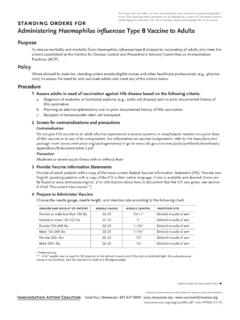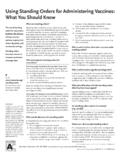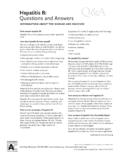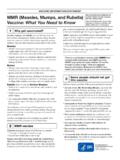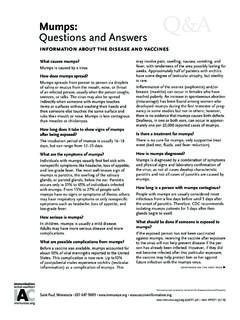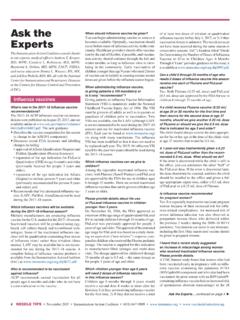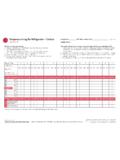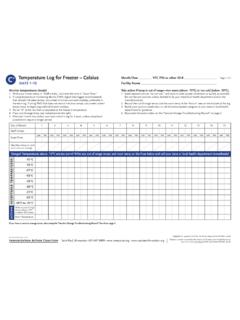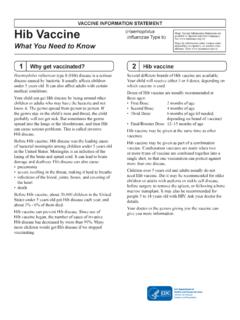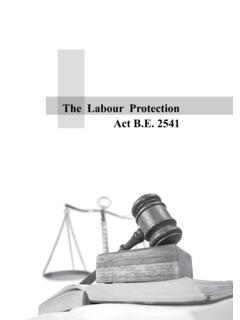Transcription of Hepatitis B and Healthcare Personnel
1 Hepatitis B VaccinationWhich people who work in Healthcare settings need Hepatitis B vaccine?The occupational safety and health adminis -tration (OSHA) requires that Hepatitis B vac-cine be offered to Healthcare Personnel (HCP) who have a reasonable expectation of being exposed to blood or body fluids on the job. This requirement does not include per- sonnel who would not be expected to have occupational risk ( , general office workers).At what anatomic site should Hepatitis B vaccine be administered to adults? What needle size should be used?For adults, administer Hepatitis B vaccine intra- muscularly (IM) in the deltoid muscle. A 22- to 25-gauge, 1 1 -inch needle should be used. The gluteus muscle should not be used as a site for administering Hepatitis B vaccine. For optimal protection, it is crucial that the vac-cine be administered IM, not Heplisav-B be used for vaccinating Healthcare professionals?
2 Yes. Heplisav-B (Dynavax) was approved by the Food and Drug Administration in Novem-ber 2017 for persons 18 years of age and older. Heplisav-B contains a novel immunos-timulatory adjuvant (CpG 1018) that binds to Toll-like receptor 9 to stimulate a directed immune response to HBsAg. It is provided in a single dose mL vial and given as a 2-dose schedule. The doses should be sepa-rated by at least 4 Heplisav-B be used to complete a vaccination series started with Engerix-B or Recombivax HB? A HepB vaccine series that was begun with Engerix-B (GSK) or Recombivax HB (Merck) may be completed with Heplisav-B. However, data are limited on the safety and immunoge-nicity effects when Heplisav-B is interchanged with Hepatitis B vaccines from other manufac-turers. When feasible, the same manufactur-er s vaccines should be used to complete the series. However, vaccination should not be deferred when the manufacturer of the previ-ously administered vaccine is unknown or when the vaccine from the same manufac-turer is 2-dose Hepatitis B vaccine series only applies when both doses in the series consist of Heplisav-B.
3 Series consisting of a combi-nation of 1 dose of Heplisav-B and a vaccine from a different manufacturer should consist of 3 total vaccine doses and should adhere to the 3-dose schedule minimum intervals of 4 weeks between dose 1 and 2, 8 weeks between dose 2 and 3, and 16 weeks between dose 1 and 3. Doses administered at less than the minimum interval should be repeated. However, a series containing 2 doses of Heplisav-B administered at least 4 weeks apart is valid, even if the patient received a single earlier dose from another a person who works in a Healthcare setting had one dose only of Hepatitis B vaccine 1 year ago, should the series be restarted?No. The Hepatitis B vaccine series should not be restarted when doses are delayed; rather, the series should be continued from where it stopped. Is it safe for HCP to be vaccinated during pregnancy?Yes. Both Engerix-B [GSK] and Recombivax HB [Merck]) may be administered during pregnancy.
4 Many years of experience with these two vaccines indicate no apparent risk for adverse events to a developing fetus. Cur-rent Hepatitis B vaccines contain noninfec-tious Hepatitis B surface antigen (HBsAg) and should pose no risk to the fetus. If not vaccinated, a pregnant woman may contract an HBV infection during pregnancy, which might result in severe disease for the new-born. Women who breastfeed their babies and are Healthcare professionals can and should be vaccinated against Hepatitis B if they haven t been previously vaccinated. Receipt of the vaccine is not a reason to dis-continue are no clinical studies of Heplisav-B in pregnant women. Available human data on Heplisav-B administered to pregnant women are insufficient to assess vaccine-associated risks in pregnancy. Until safety data are avail-able for Heplisav-B, providers should con-tinue to vaccinate pregnant women needing Hepatitis B vaccination with a vaccine from a different there a recommendation for routine booster doses of Hepatitis B vaccine?
5 No. HCP who have documentation of receiv-ing a complete series of Hepatitis B vaccine and who subsequently tested positive for anti-HBs (defined as anti-HBs of 10 mIU/mL) are considered to be immune to Hepatitis B. Immunocompetent persons who also have followed the protocol, have long-term pro-tection against HBV and do not need further testing or vaccine doses. Some immuno- deficient persons, including those on hemo-dialysis, may need periodic booster doses of Hepatitis B vaccine. We have a new employee with documenta-tion of having received a series of Hepatitis B vaccine as an adolescent. He now tests negative for Hepatitis B surface antibody (anti-HBs). How should we manage him?ACIP recommends that Healthcare Personnel with written documentation of having received a properly spaced series of Hepatitis B vac-cine in the past (such as in infancy or adoles-cence) but who now test negative for anti-HBs should receive a single booster dose of Hepatitis B vaccine and be retested 1 2 months later (see Figure 1).
6 Those who test positive following the booster dose are immune and require no further vaccination or testing. Those who test negative should complete a second series of Hepatitis B vaccine on the usual schedule and be tested again 1 2 months after the last dose. Heplisav-B may be used to revaccinate new Healthcare per-sonnel (including the challenge dose) initially vaccinated with a vaccine from a different Saint Paul, Minnesota 651-6 47-9009 Item #P2109 (2/20)continued on the next page Q&AHepatitis B and Healthcare Personnel IAC answers frequently asked questions about how to protect Healthcare personnelExperts from the Immunization Action Coalition (IAC) answer your questions about Hepatitis B (HepB) vaccine. You ll find additional Q&As about Hepatitis B vaccine on the Ask the Experts section of at manufacturer in the distant past who have anti-HBs less than 10 mIU/mL upon hire or matriculation.
7 For more information, see , pages 21 Anti-HBs TestingWhich HCP need serologic testing after receiving a Hepatitis B vaccine series?All HCP, including trainees, who have a high risk of occupational percutaneous or mucosal exposure to blood or body fluids (for example, HCP with direct patient contact, HCP at risk of needlestick or sharps injury, laboratory workers who draw, test or handle blood spec-imens) should have postvaccination testing for antibody to Hepatitis B surface antigen (anti-HBs). Postvaccination testing should be done 1 2 months after the last dose of vac-cine. Postvaccination testing for persons at low risk for mucosal or percutaneous expo-sure to blood or body fluids (for example, public safety workers and HCP without direct patient contact) likely is not cost-effective; however, those who do not undergo post- vaccination testing should be counseled to seek immediate testing if exposed.
8 Hepatitis B and Healthcare Personnel (continued) page 2 of 5 Immunization Action Coalition Saint Paul, Minnesota 651-6 47-9009 Item #P2109 (2/20)continued on the next page Healthcare Personnel (HCP) with documen- tation of a complete series of HepB vaccine but no documentation of anti-HBs 10 mIU/mL who are at risk for occupational blood or body fluid exposure might undergo anti-HBs testing upon hire or matriculation. The algo- rithm at right will assist in the management of these people. It was adapted from CDC. Prevention of Hepatitis B Virus Infection in the United States: Recommendations of the Advisory Committee on Immunization Practices, MMWR 2018; 67(RR-1), available at : Also available as stand-alone form at serologic testing may be recommended for all previously vaccinated HCP who were not tested 1 to 2 months after the third dose (such as people vaccinated as children or adolescents).
9 Trainees, HCP in certain occupations, and HCP practicing in certain populations are at greater risk of exposure. Vaccinated HCP in these settings or occupations could benefit from pre-exposure serologic be performed 1 2 months after the last dose of vaccine using a quantitative method that allows detection of the protective concentration of anti-HBs ( 10 mlU/mL) ( , enzyme-linked immunosorbent assay [ELISA]).A nonresponder is defined as a person with anti-HBs <10 mIU/mL after 2 complete series of HepB vaccine. Persons who do not have a protective concentration of anti-HBs after revaccination should be tested for HBsAg. If positive, the person should receive appropri-ate management. See MMWR 2018;67(RR-1) at for guidance on management of persons who do not respond to 2 complete series of HepB vaccine. * No action needed for Hepatitis B prophylaxis (regardless of the source of the patient s Hepatitis B surface antigen status) Measure antibody to Hepatitis B surface antigen (anti-HBs)*anti-HBs <10mlU/mLanti-HBs 10 mlU/mLanti-HBs <10 mlU/mLanti-HBs 1 0 mlU/mL anti-HBs <10 mlU/mLanti-HBs 1 0 mlU/mLHCP need to receive Hepatitis B evaluation for all exposures Administer 1 dose of HepB vaccine.
10 Perform postvaccination serologic testing 1 2 months after vaccine dose. figure 1. Pre-exposure Management for Healthcare Personnel with a Documented Hepatitis B Vaccine Series Who Have Not Had Post-vaccination Serologic Testing Complete a second series of HepB vaccine. Perform postvaccination serologic testing 1 2 months after completion of series. What should be done if a person s post- vaccination anti-HBs test is negative (less than 10 mIU/mL) 1 2 months after the last dose of vaccine?Repeat the 2- or 3-dose series (depending on vaccine brand) and test for anti-HBs 1 2 months after the final dose of the repeat series. Heplisav-B may be used for revaccination following an initial Hepatitis B vaccine series that consisted of doses of Heplisav-B or doses from a different manufacturer. Heplisav-B may also be used to revaccinate new health -care Personnel (including the challenge dose) initially vaccinated with a vaccine from a dif-ferent manufacturer in the distant past who have anti-HBs less than 10 mIU/mL upon hire or the test is still negative after a second vac-cine series, the person should be tested for HBsAg and total anti-HBc to determine their HBV infection status.
